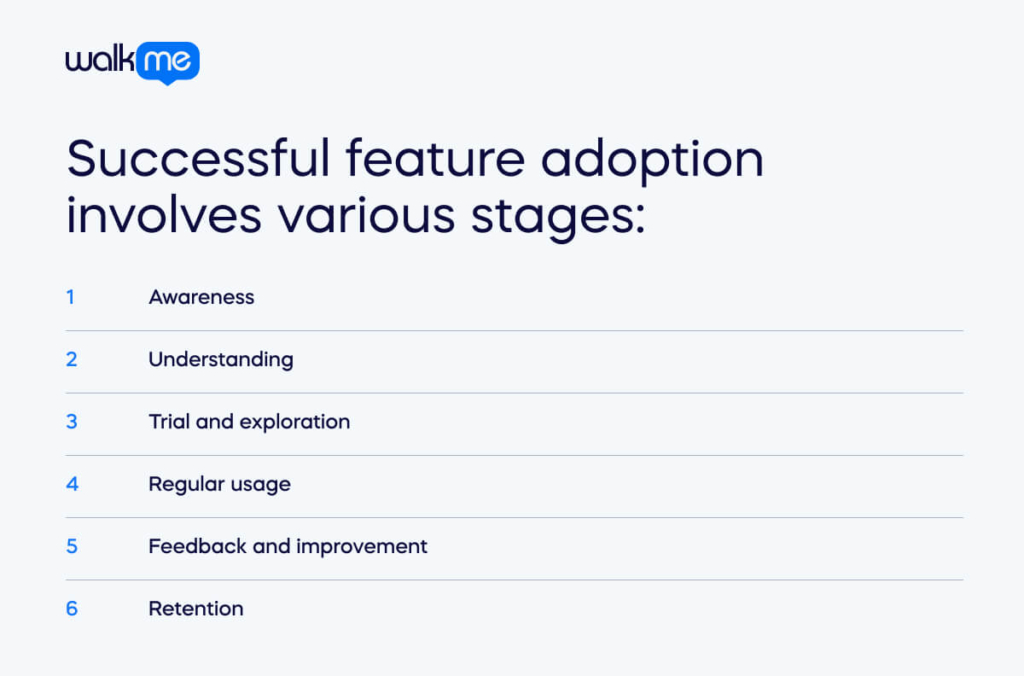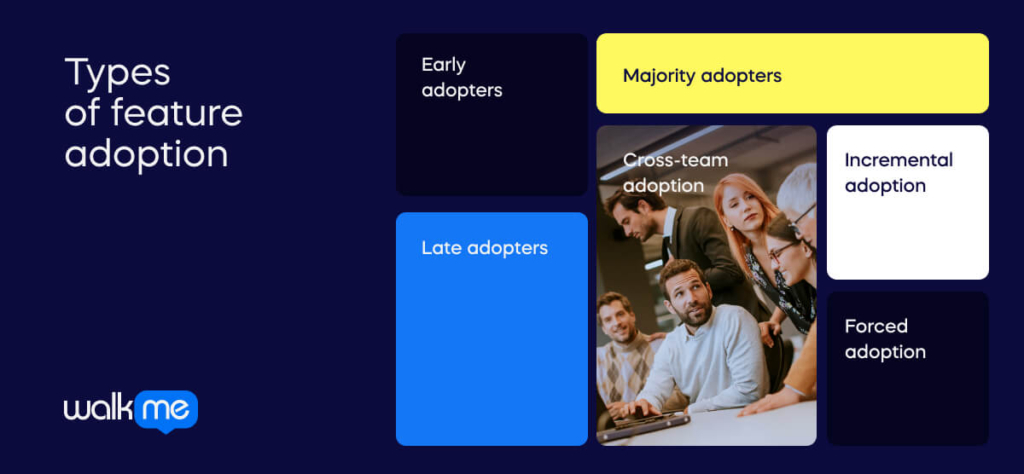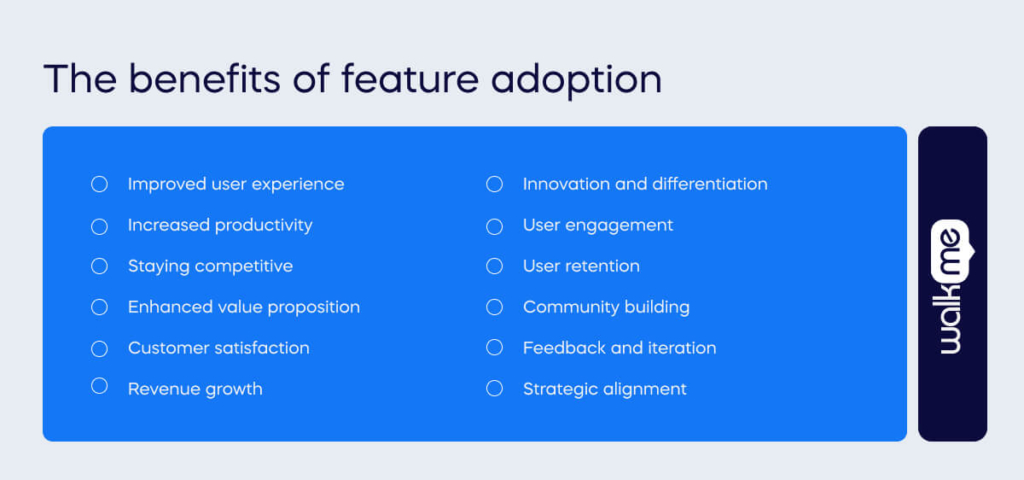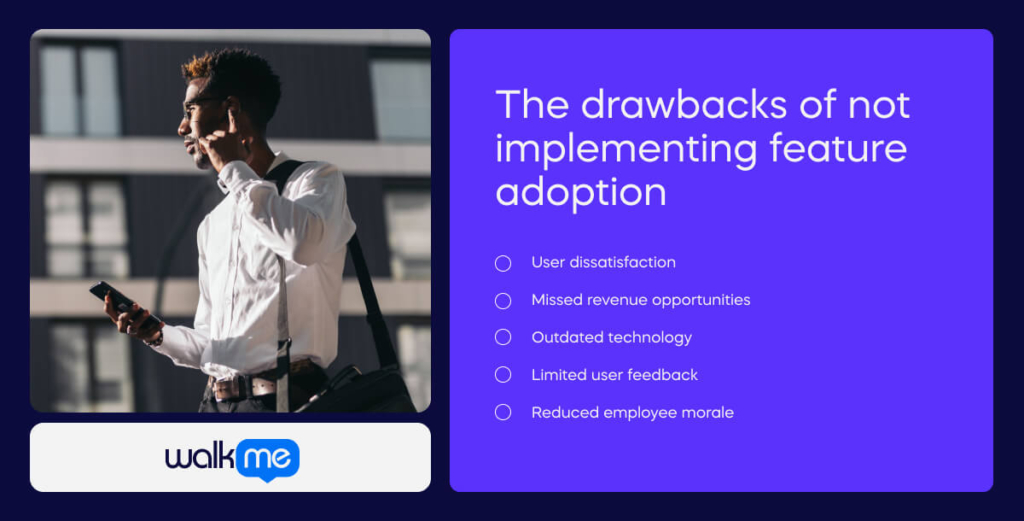What is feature adoption?
Feature adoption refers to the process by which users start using and integrating new features or functionalities offered by a product, service, or software application.

Table of contents
- What is feature adoption?
- Types of feature adoption
- What are the benefits of feature adoption?
- What are the drawbacks of not implementing feature adoption?
- Feature adoption vs product adoption
- Examples of feature adoption in the workplace
- Big businesses and feature adoption
- How is a feature adoption strategy rolled out?
It is a crucial aspect of user engagement and the overall success of a product.
When a new feature is introduced, it may take some time for users to become aware of it, understand its value, and incorporate it into their regular usage.
Successful feature adoption involves various stages:

Awareness
Users need to be aware that a new feature exists. This can be achieved through effective communication, such as release notes, in-app notifications, or email announcements.
Understanding
Users must understand the purpose and benefits of the new feature. Clear and concise documentation, tutorials, or tooltips can help users grasp how the feature works and why it might benefit them.
McKinsey’s research reveals that there has been a resurgence of enthusiasm about technology’s potential to catalyze progress in business, which feature adoption strategies that can further assist.
Trial and exploration
Users may try out the new feature to explore its functionality. Providing a seamless and intuitive user experience during this phase is crucial to encourage further exploration.
Regular usage
Once users see the value in the new feature, they are more likely to incorporate it into their regular workflow or usage patterns. The goal is to make the feature integral to the user’s experience.
Feedback and improvement
Continuous feedback loops are essential for understanding how users interact with the feature. This feedback can be used to improve, fix bugs, and enhance the feature based on user input.
Retention
Long-term success is measured by the sustained adoption of the feature over time. Retention efforts ensure that users continue to find value in the feature and don’t abandon it over time.
Types of feature adoption

Feature adoption can be categorized into different types based on the characteristics of the users and their interactions with the new features.
Here are some common types of feature adoption:
Early adopters
Early adopters are the first group of users to embrace and use a new feature shortly after its introduction.
Also seen in the technology adoption curve, these users are often more technologically savvy, open to experimentation, and willing to take risks.
Focusing on this group helps gather initial feedback and generate positive buzz, which can influence later adopters.
Majority adopters
Most adopters make up the largest segment of users who gradually adopt a new feature after early adopters have accepted it.
These users may be more cautious and wait to confirm the feature’s value before adopting it.
Building user confidence through testimonials, case studies, and demonstrating the widespread use of the feature can encourage majority adopters.
Late adopters
Late adopters are users who are hesitant or slow to adopt new features and may only do so after extensive validation and mainstream acceptance.
These users tend to be more risk-averse and prefer stability over innovation.
Providing comprehensive documentation, addressing concerns, and showcasing the stability and success of the feature can help win over late adopters.
Cross-team adoption
In organizational settings, features may need to be adopted by different teams or departments.
Different teams may have unique workflows and requirements, making it essential to tailor adoption strategies to each group.
Customizing communication and training materials for specific teams, addressing their unique needs, and fostering collaboration can enhance cross-team adoption.
Incremental adoption
Users gradually adopt new features over time, incorporating them into their existing workflows in stages.
This type of adoption may involve a phased approach where users integrate the feature bit by bit.
Providing step-by-step guidance, offering support during the transition, and ensuring backward compatibility can facilitate incremental adoption.
Forced adoption
In some cases, users may be compelled to adopt a new feature due to external factors such as software updates, policy changes, or discontinuation of older features.
Users may not have a choice in adopting the feature, and resistance may initially be higher.
Clear communication, training, and addressing concerns promptly can help ease the transition during forced adoption scenarios.
What are the benefits of feature adoption?

Feature adoption brings several benefits to both users and the providers of products or services.
Here are some key advantages:
Improved user experience
Adopting new features often leads to enhanced user experiences.
New functionalities, improved workflows, and additional capabilities create a more satisfying and efficient user experience.
Increased productivity
Features designed to streamline processes or automate tasks can significantly boost user productivity.
Users who adopt and integrate these features into their workflows can accomplish tasks more efficiently.
Staying competitive
Regularly introducing new features helps businesses stay competitive in the market.
Adopting the latest technologies and addressing user needs ensures that a product remains relevant and appealing to users.
Enhanced value proposition
New features can add value to a product or service, attracting new users and retaining existing ones.
A robust set of features strengthens the overall value proposition, making the product more attractive to potential customers.
Customer satisfaction
Meeting user expectations and addressing their evolving needs through new features increases customer satisfaction.
Satisfied users are likelier to remain loyal and recommend the product to others.
Revenue growth
Successful feature adoption can lead to increased revenue.
New features may attract new customers, encourage existing users to upgrade their subscriptions or provide opportunities for monetization through upsells or additional services.
Innovation and differentiation
Feature adoption is a key driver of innovation.
Introducing novel features allows a product to stand out in the market, differentiating it from competitors and demonstrating a commitment to continuous improvement.
User engagement
Features that align with user needs and preferences can boost user engagement.
Users are likelier to actively use and explore a product with relevant and valuable features.
A Gartner survey reveals that marketers use only 42% of their martech stack capabilities, down from 58% in 2020. Rolling out feature adoption strategies could help boost numbers like these.
User retention
Regularly updating a product with new features helps retain users by keeping them interested and invested in the platform.
Users are less likely to churn if they see ongoing improvements and additions to the product.
Community building
Successful feature adoption can foster a sense of community among users.
Shared experiences and collaboration around new features can lead to the formation of user communities, which can further contribute to product success.
Feedback and iteration
Feature adoption provides an opportunity to collect valuable user feedback.
Users who adopt new features early often provide insights that can be used to refine and iterate on the features, improving them over time.
Strategic alignment
Features aligned with the strategic goals of a business or organization contribute to overall success.
Feature adoption ensures that the product evolves in a direction that supports the company’s vision and objectives.
What are the drawbacks of not implementing feature adoption?

Not implementing feature adoption strategies or neglecting the process can lead to several drawbacks and challenges for both users and providers of products or services.
Here are some potential drawbacks:
User dissatisfaction
Users may become dissatisfied if a product lacks new features and improvements.
Frustration may arise if competitors offer more innovative solutions, leading users to consider alternatives that better address their evolving requirements.
Missed revenue opportunities
New features often present opportunities for revenue growth, such as introducing premium features, upselling, or additional services.
Not capitalizing on these opportunities may limit the financial success of the product.
Outdated technology
Failing to adopt new features may result in the use of outdated technologies.
This can lead to compatibility issues, security vulnerabilities, and challenges in maintaining the product’s overall performance and reliability.
Limited user feedback
Feature adoption often provides an avenue for collecting valuable user feedback.
Without introducing new features, the opportunity to gather insights into user preferences, pain points, and suggestions may be missed.
Reduced employee morale
Internally, a lack of focus on feature adoption may affect the morale of the development and product teams.
The absence of new challenges and innovative projects can decrease motivation and job satisfaction.
Feature adoption vs product adoption
Feature adoption and product adoption are related concepts, but they refer to different aspects of a user’s interaction with a product or service.
Here’s a comparative overview:
| Feature adoption | Product adoption |
| Focuses on accepting and integrating specific functionalities or features within a product or service. | A broader concept that encompasses the overall acceptance and usage of the entire product or service. |
| Involves users becoming aware of, understanding, and actively using new features introduced by the provider. | Involves users embracing the core offering and all its features, understanding its value proposition, and making it an integral part of their routine. |
| Narrower in scope, addressing the implementation and acceptance of individual features or capabilities rather than the product as a whole. | Addresses the user’s relationship with the entire product, considering its core functionalities, user interface, and overall user experience. |
| Example of feature adoption | Example of product adoption |
| If a messaging app introduces a new voice messaging feature, the process of users starting to use and incorporate this specific feature into their communication would be considered feature adoption. | If a company releases a new version of its project management software with several new features, product adoption would involve users not only adopting those new features but also embracing the updated interface, improved performance, and any other changes that come with the new version. |
Both types of adoption are important for the success of a product.
Feature adoption contributes to the evolution and improvement of specific aspects, while product adoption reflects the product’s overall success in the market.
Examples of feature adoption in the workplace
Feature adoption in the workplace is important, as the process allows employees to embrace and integrate new features or functionalities within digital tools, software, or systems used for work-related tasks.
Here are some examples of feature adoption in the workplace:
Collaboration tools
A company introduces a new collaboration tool with features like real-time document editing, task management, and video conferencing.
Employees gradually adopt these features to enhance team collaboration, communication, and project coordination.
Project management software
A project management software is updated with a new feature allowing agile project tracking.
Team members use this feature to plan sprints, manage backlogs, and improve overall project visibility.
Customer relationship management (CRM) system
A CRM system introduces a new analytics dashboard that provides in-depth insights into customer behavior and sales performance.
Sales and marketing teams adopt this feature to make data-driven decisions, track key metrics, and optimize their strategies.
Communication platforms
A company implements a new internal communication platform with features like channels, integrations, and threaded conversations.
Employees gradually adopt these features for team communication, announcements, and sharing updates.
Expense management software
An updated expense management system includes a mobile app that allows employees to capture receipts, submit expenses, and track approvals on the go.
Employees adopt these mobile features for more convenient and efficient expense reporting.
Learning management system (LMS)
An organization updates its LMS to include interactive and gamified learning modules.
Employees embrace these features to make training more engaging, track their progress, and acquire new skills.
Human resources software
A human resources software solution introduces a new feature for employee self-service, enabling staff to manage their leave requests, update personal information, and access HR-related resources.
Employees adopt these self-service features for greater autonomy and convenience.
Document collaboration platforms
A document collaboration platform introduces a feature that allows real-time co-authoring and version history tracking.
Teams adopt these features to improve document collaboration, reduce errors, and maintain a clear audit trail of changes.
Task management applications
An updated task management application introduces a feature for setting dependencies and timelines.
Project managers and team members adopt these features to better plan and execute tasks in a structured and organized manner.
Intranet features
An organization enhances its intranet with new features such as employee recognition tools, discussion forums, and knowledge-sharing capabilities.
Employees adopt these features to build a stronger sense of community, share expertise, and acknowledge their peers.
Big businesses and feature adoption
Big brands often employ diverse strategies to tackle feature adoption and ensure users actively embrace and incorporate new functionalities into their interactions with products or services.
Here are some examples of how notable brands have approached feature adoption:
Apple – iPhone updates
Apple regularly releases new iOS updates with additional features and improvements.
They use a combination of in-app notifications, emails, and marketing campaigns to inform users about the new features.
The seamless integration of these updates into the existing user interface encourages users to adopt the latest features.
Microsoft – Office 365
Microsoft continually updates its Office 365 suite with new features and capabilities.
They often provide detailed release notes, tutorials, and video guides to help users understand and adopt the new features.
Additionally, Microsoft promotes these updates through newsletters, webinars, and in-app notifications.
Google – Gmail smart compose
Google introduced Smart Compose in Gmail, an AI-powered feature that suggests phrases as users type emails.
To encourage adoption, Google introduced Smart Compose gradually, allowing users to enable or disable it as they wished.
The feature was presented as a time-saving tool, and tooltips were used to guide users on how to use it effectively.
Facebook – news feed features
When Facebook introduces new features to its News Feed, such as reactions or timeline updates, it often uses a phased rollout strategy.
Initially, a small group of users gets access, generating curiosity and early adoption.
As positive feedback accumulates, the feature gradually expands to a wider audience.
LinkedIn – skill assessments
LinkedIn introduced skill assessments to validate users’ proficiency in specific skills.
LinkedIn prompts users to showcase their skills by taking short assessments to encourage adoption.
The results are displayed on their profiles, providing a tangible benefit and recognition for users who engage with the new feature.
Netflix – personalized recommendations
Netflix continuously enhances its recommendation algorithm to provide personalized content suggestions.
The adoption strategy subtly introduces users to personalized recommendations and emphasizes the value of curated content.
Users are encouraged to rate shows and movies to improve the accuracy of recommendations.
Amazon – Alexa skills
Amazon encourages feature adoption on its Alexa platform through marketing campaigns, partnerships, and developer incentives.
They promote new Alexa skills through various channels, including the Alexa Skills Store, newsletters, and social media.
Competitions and rewards for skill developers also drive innovation and adoption.
Tesla – over-the-air updates
Tesla uses over-the-air updates to introduce new features and improvements to its electric vehicles.
The updates are often accompanied by release notes explaining the new functionalities.
Tesla owners receive notifications about the updates, creating anticipation and excitement for the new features.
Adobe – Creative Cloud updates
Adobe regularly updates its Creative Cloud applications with new features and enhancements.
Adobe provides users with detailed documentation, tutorials, and video content to help them understand and adopt the latest tools.
In-app notifications and prompts guide users to explore and use new features.
Slack – Workflow Builder
Slack introduced Workflow Builder to enable users to automate routine tasks.
To encourage adoption, Slack provides templates and guides users through the process of creating custom workflows.
They also use in-app prompts and announcements to inform users of the new feature.
How is a feature adoption strategy rolled out?
Creating, assessing, and rolling out a feature adoption strategy involves careful planning, communication, and iterative improvement.
Here’s a step-by-step guide on how to approach each phase:
Planning feature adoption strategy
Understand user needs
Conduct user research to understand the needs, preferences, and pain points of your target audience. Identify what features would bring the most value to users.
Define clear objectives
Clearly define the objectives of introducing the new feature. What problems will it solve for users? How will it benefit the overall product or service?
Segment your audience
Identify different user segments based on factors like behavior, preferences, and usage patterns. Tailor your adoption strategy to the unique characteristics of each segment.
Set key performance indicators (KPIs)
Establish measurable KPIs to track the success of the feature adoption strategy. KPIs could include user engagement metrics, conversion rates, and user satisfaction scores.
Create a communication plan
Develop a comprehensive communication plan that outlines how you will inform users about the new feature. Consider using a variety of channels, such as in-app messages, emails, blog posts, and social media.
Provide training and resources
Develop training materials, tutorials, and documentation to help users understand and effectively use the new feature. Consider creating video tutorials, FAQs, and interactive guides.
Assessing feature adoption strategy
Monitor key metrics
Regularly monitor key metrics to assess the adoption progress. Track user engagement, feature usage patterns, and user feedback to understand how well the feature is being adopted.
Collect user feedback
Actively seek feedback from users who have adopted the feature. Understand their experiences, challenges, and suggestions. This feedback can be invaluable for making iterative improvements.
Analyze user behavior
Use analytics tools to analyze user behavior within the application. Identify patterns, drop-off points, and areas where users may be struggling to adopt the feature.
Gather qualitative data
Conduct surveys, interviews, or usability testing to gather qualitative data. This can provide deeper insights into user perceptions and help identify areas for improvement.
Iterative improvement and rollout
Iterate based on feedback
Use the insights gathered from user feedback and analytics to make iterative improvements to the feature and the adoption strategy. Address any usability issues or concerns raised by users.
A/B testing
If feasible, consider conducting A/B testing to compare different variations of the adoption strategy. This can help identify the most effective communication methods, training materials, or incentives.
Scale adoption efforts
Once the initial feedback and improvements have been implemented, scale your adoption efforts. Consider expanding communication to a broader user base and refining the training materials based on lessons learned.
Celebrate milestones
Celebrate milestones and achievements in feature adoption. Acknowledge and reward users who actively engage with the new feature. This positive reinforcement can encourage continued adoption.
Sustain engagement
Implement ongoing strategies to sustain user engagement with the feature. This could include regular updates, additional enhancements, and continued communication about the value of the feature.